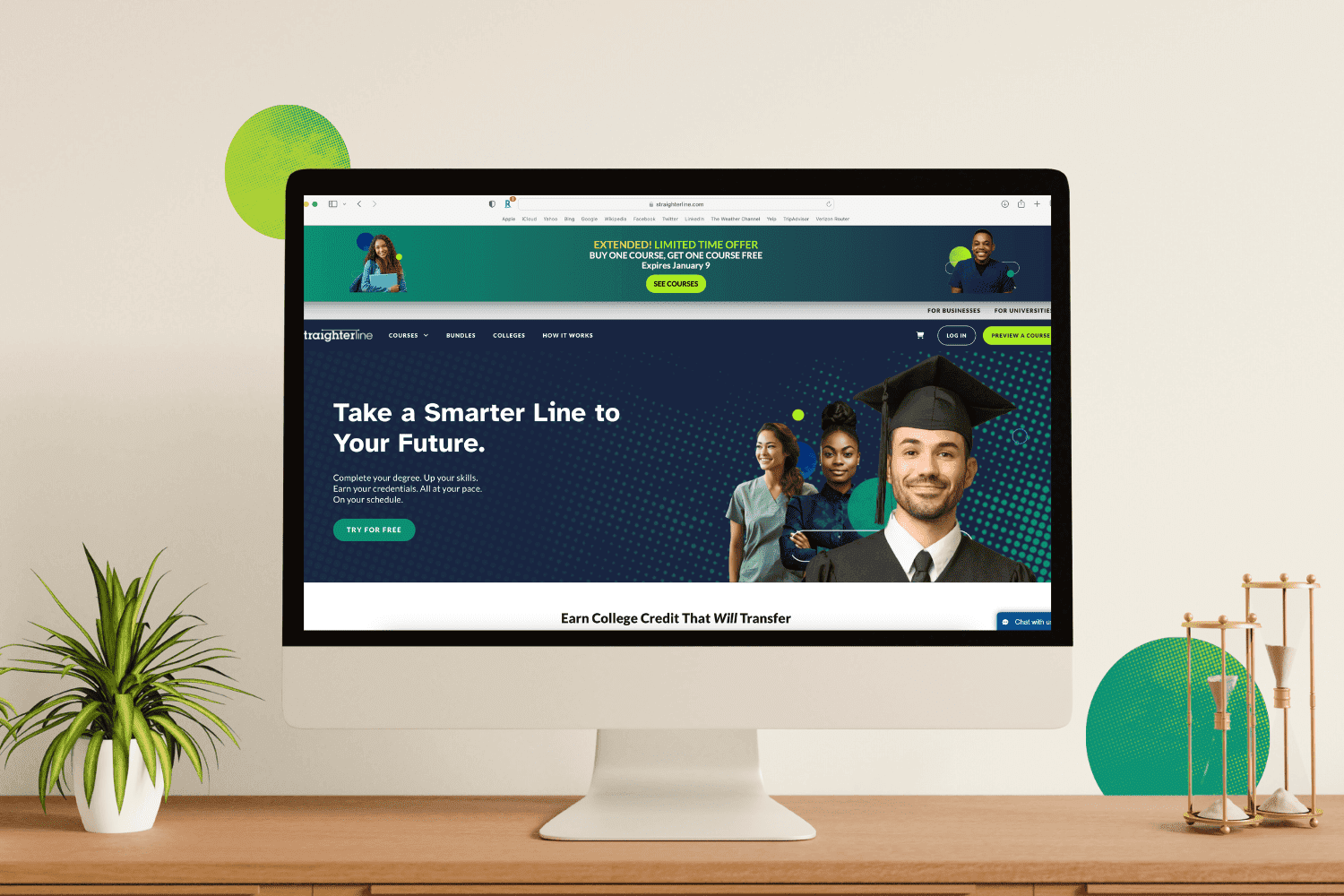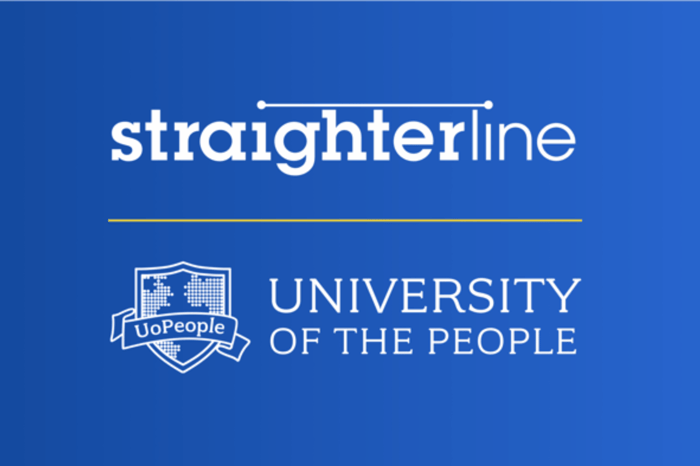No matter your situation — whether you never went to college, you didn’t finish, or you’re going back to college for professional development — it’s possible to restart your academic career. In fact, you might even be in a position where you’re better equipped to make decisions about your education than you were as a teenager. And you’re not alone: in 2022, nearly a quarter of undergraduates were age 25 and older.
With online learning more accessible than ever, there’s never been a better time for adult learners to go back to college to continue or finish a degree — or earn a new one!
The Benefits of Going Back to College
There are many benefits of going back to college as an adult. The largest may be your salary.
Typically, those with a bachelor’s degree earn $30,888 more per year than those with only a high school diploma.
In addition to a significant salary boost, going back to college can help you switch careers or advance in your profession. For many, earning a college degree also fulfills a life goal.
Whatever your reason, it’s almost always a good idea to go back to school.
The Steps to Going Back to College: Your Back to College Checklist
Going back to school may be an easy decision, but getting started may be more challenging. This checklist will help you feel confident and ready to go!
Step 1: Do a Personal Assessment
As you prepare to go back to college, ask yourself some important questions and be honest with your answers. This helps you set realistic goals so you can discover the most fulfilling path. Ask yourself:
- What skills do I have? Make a list of past work experiences, tasks, or achievements. Were you good at them? What did you like about those experiences? What did you dislike?
- What are my interests? Consider the activities you enjoy. What are you naturally good at? What makes you happy outside of work? What don’t you like doing in your spare time?
- What are my work values? Consider what kind of work environment or projects you’ll be the happiest with. Do you prefer to work alone or with others? Working with your hands or mental work? Indoors or out? Office or home? Do you thrive under tight deadlines? How well do you handle chaos?
- What’s my current situation? Keep in mind your specific circumstances and goals. Did you never go to college in the first place? Are you going back to finish a degree? Are you hoping to pursue some professional goals?
- How much time can I devote to classes? Be realistic about your time and commitments. Are you working full-time or taking care of a family? Are you willing to take courses part-time, even though it might take longer to complete your degree?
- How will I afford this? If you can’t pay out of pocket, how will you pay for tuition? Will you have to cut back on your work hours or take a leave of absence? How will you pay for your other living expenses during this time? Are you eligible for financial aid? Can you apply for scholarships?
Once you’ve taken the time to reflect, you’ll have a better understanding of your interests, needs, and the sorts of academic and professional pursuits that will be fulfilling for you. Use these findings to start investigating career paths, colleges, and/or course options that align with your skills and interests.
It’s never too late to earn a college degree.
Step 2: Consider Your Options
Once you have a better idea of the path you want to take, it’s time to consider different learning options. Just like it’s important to understand your needs, interests, and strengths, it’s also important to make a careful and informed decision about how you pursue your degree.
Different pathways work better for different people. Here are some factors to keep in mind when comparing your options:
Class Format & Schedule
Some schools or education options may have asynchronous classes, meaning you watch lectures or instructional videos on your own time and at your own pace. Others have synchronous classes, where you’re expected to be in a classroom or on a video call at a given time.
For working adults on a tight schedule, asynchronous classes might better fit your lifestyle, so look for schools and platforms with this option.
Cost
Various educational options will have different costs associated with them, including tuition, books, and other expenses like lab fees for science courses.
If you choose to attend classes in person, make sure you also consider living or transportation costs.
Prerequisites
While most degree programs don’t have certain course requirements for admission, you may find that some programs have prerequisites for more advanced courses or additional general education requirements you’re expected to complete to earn your degree.
Pay attention to these requirements so you can set yourself up for success, especially if you already have some college credits and you’re planning on changing majors or pursuing a different degree than the one you began.
Open Enrollment & Rolling Institutions
Open enrollment institutions are places where you can register to take classes as you need, as long as you pay the tuition and fees. Online and community colleges often offer open enrollment and provide developmental courses for students who need to address educational gaps or take certain classes before starting a program.
One of the advantages of some online institutions is that in addition to open enrollment, they also offer rolling enrollment. This means you can start and finish your courses at your own pace rather than according to a calendar schedule. For some, this may mean taking a class quickly; for others, more slowly.
Associate Programs
Associate degrees are undergraduate degrees that are typically earned in two years. It’s the level of qualification above a high school diploma but below a bachelor’s degree. Normally, online colleges, community colleges, and technical colleges offer this degree.
For many, an associate degree can lead to a bachelor's degree through credit transfer to a 4-year public college, particularly for those who start at a public community college. We’ll discuss the credit transfer process in more detail below.
Bachelor Programs
Bachelor's degrees are the most common and traditional college degrees. These programs, which are generally completed in about four years, include studying a specific subject within a major or a particular program.
Almost all traditional colleges offer bachelor's degree programs, but some are more selective in admitting students than others. There are also plenty of online institutions that offer bachelor's degree programs.
Online bachelor’s degree programs rose in popularity during lockdown, and they’re still popular. The reasons for this include the flexibility and low cost that online programs offer. For some students, the ability to take classes anywhere and at any time is a huge advantage.
Online Education Options
Online learning is a great option for many people looking to pursue a college degree. Many online education programs offer a variety of degrees or courses that students can take to earn credits.
Most online education providers also offer opportunities to transfer credits from their classes to other institutions of higher education. They’re an affordable way to fulfill any prerequisites you might need for a particular major.
For example, while StraighterLine doesn’t offer degrees, we do have over 70 courses that students can take to earn credits and transfer them to one of our partner colleges or another college or university that accepts ACE-recommended credits.
Step 3: Learn About the College Credit Transfer Process
Depending on the educational option you choose, you may need to become familiar with the credit transfer process. Although it can seem confusing, some online platforms, like StraighterLine, will guide you through it.
Make sure to contact the appropriate office of the college you plan to transfer to in order to understand their policy and identify course equivalencies. A course equivalency tells you which classes taken elsewhere are equal to specific courses offered by the receiving institution and are, therefore, acceptable as transfer credits.
Make sure you have access to previous transcripts earned at other institutions and can provide the necessary information for your transfer school.
You may have credits available for transfer if:
- You have previous college credits
- You’re going from a two-year degree program to a four-year program
- You’ve taken prerequisite or general education courses online
- Your past work experience includes continuing education exams
- You have military training
There’s no guarantee that your transfer school will accept your previous credits. Accepting these credits is up to the receiving school. Some schools have partnership agreements with education providers that will guarantee transfer credit. StraighterLine, for example, partners with over 150 colleges to guarantee credit transfer to any of these institutions.
Familiarize yourself with your intended school’s credit transfer policies before earning credits somewhere else.
Step 4: Understand the Cost of College & Your Finances
While going back to college may seem like a significant financial commitment, remember that your education is an investment. (Remember earlier when we discussed how much more money you can make with a degree?) You’re spending money now that will pay off throughout the rest of your professional life.
In some cases, you’ll pay out of pocket to go to college. How much you pay, however, largely depends on the type of institution you choose. Keep in mind that there’s always financial help available, too. To make sure that you’re setting yourself up for success — academically, professionally, and financially — consider all of your financial options.
Federal Loans
The U.S. Department of Education offers federal loans, which are divided into two categories: subsidized and unsubsidized.
Subsidized loans are determined based on your financial need, and these types of loans will not charge you interest while you’re in school. To be considered for a subsidized loan, you’ll need to fill out the Free Application for Federal Student Aid (FAFSA) form.
To receive an unsubsidized loan, you do not need to demonstrate financial need, but these types of loans will immediately start to accrue interest, even while you’re still in school.
Private Loans
Private loans are loans that you can take out from a bank or other financial institution. These loans may be more expensive and have higher interest rates than federal loans.
Federal & State Grants
The federal and some state governments offer a variety of grants that you may be able to apply for and use toward your education. There are three common types of federal grants:
- Federal Pell Grant: These grants are awarded to students who display exceptional financial need and are working toward a bachelor’s, graduate, or professional degree. Pell grants do not need to be repaid.
- Federal Supplemental Educational Opportunity Grant (FSEOG): These grants are also awarded to students who display exceptional financial need, but they’re awarded directly through a school’s financial aid office. These grants do not need to be repaid.
- Teacher Education Assistance for College and Higher Education Grant (TEACH): These grants require recipients to complete a teaching service obligation. They must be repaid with interest.
For state grants, you can check your state’s education website for more information.
Private Scholarships
There are many institutions, organizations, and communities that offer scholarships for a wide variety of students meeting different eligibility criteria to attend college. Some even offer scholarships for “non-traditional” students, including adults who may be going back to college. There are several websites, including Scholarships360, that keep updated databases of available scholarships and tips on how to apply.
Employer Tuition Reimbursement
Employer tuition reimbursement is when your employer covers some or all of the costs of your education. In many cases, this happens when you’re pursuing a professional degree or certification.
Not all companies offer reimbursement, but if you’re working full-time and you’d like to increase your skills in your current career, this is a great option to investigate. Check with your company’s HR department to find out if they offer an employer tuition reimbursement program.
Non-Traditional Degree Options
Non-traditional degree paths, like taking some courses online and then transferring the credit to the college of your choice, can have a huge impact on your savings. By taking courses online and at your own pace, you can put your money toward the courses that matter most for your goals without spending thousands of dollars on tuition or room and board.
With StraighterLine, for example, you can start taking college courses on your own time, at your own pace, for just a fraction of what they would cost at a brick-and-mortar college.
Step 5: Check In With Your Current Job
For those already working full-time, make sure to check in with your employer before you enroll in a program. You’ll need to let your employer know that you may need some time off or a change of schedule to go back to school.
This will likely impact the way you go back to school, as it will help you figure out what kind of time you can devote to your classes and what your finances/income will look like.
Step 6: Consider Job Placement & Career Opportunities
If you’re going back to school because you want a new career or you want to shift direction, make sure to keep in mind what you’ll be doing after you get your degree. It can be an important part of making your decision about how and where you’ll go back to school.
Some educational institutions are better known for certain programs or offer more robust job search and job placement support for their students. Others may have connections with certain companies or relationships within particular industries.
If you have a good grasp of the professional trajectory you want to take after leaving school, making decisions based on these types of support can make a big difference once you have your degree.
Step 7: Plan for Success
Now that you’re ready to go back to college, it’s time to plan for success! Remember: you’re investing in yourself. Stepping back into the role of a student as an adult can be challenging, mainly because your experience may be different than many of your younger academic peers. They may live on campus, and you might not. They likely don’t have many other commitments, while you may have a family or are working a part-time or full-time job.
It’s important to plan and prepare for these differences so you can achieve the educational success you deserve. Here are some tips to make the most of this exciting opportunity:
- Assess the course catalog ahead of time so you know which classes are most appropriate for your goals.
- Build a relationship with your advisor to help position yourself for success in your academic pursuits.
- Give ample consideration to your class schedule to ensure you’re setting realistic expectations for yourself and your school commitments.
- Prepare the important people in your life (boss, co-workers, family members) for what your schedule is going to look like now with your new responsibilities and priorities.
- Try part-time, low-pressure, and low-cost opportunities first, such as online courses.
- Advocate for yourself.
- Make time for self-care.
StraighterLine Can Help You Get Back to College
Become one of the tens of thousands of students taking advantage of StraighterLine’s proven education programs. With 70+ classes in diverse subjects and a guarantee of transfer credit to over 150 colleges and universities, StraighterLine is here to support you.
Returning to college has never been easier with StraighterLine’s 24/7 student support services and schedule flexibility.












